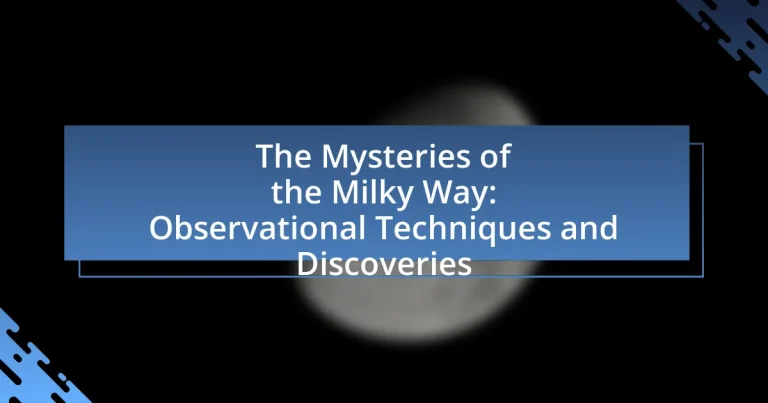The article focuses on the mysteries of the Milky Way galaxy, emphasizing key aspects such as dark matter, the formation of spiral arms, and the presence of supermassive black holes. It explores the complexities of the galaxy’s structure, including its main components like the galactic disk, central bulge, and halo, while highlighting the significance of observational techniques such as radio, infrared, and optical astronomy. The article also discusses recent discoveries that enhance our understanding of the Milky Way’s dynamics and composition, as well as the implications of these findings for future research and exploration.

What are the Mysteries of the Milky Way?
The mysteries of the Milky Way include the nature of dark matter, the formation and distribution of its spiral arms, and the existence of supermassive black holes at its center. Dark matter constitutes approximately 27% of the universe, yet its properties remain largely unknown, complicating our understanding of the galaxy’s structure. The spiral arms of the Milky Way, which contain young stars and gas, are not fully understood in terms of their formation and dynamics, leading to ongoing research. Additionally, the supermassive black hole, known as Sagittarius A*, has a mass equivalent to about 4.1 million suns, but the mechanisms of its formation and growth are still subjects of investigation. These aspects highlight the complexities and unknowns that continue to challenge astronomers and astrophysicists studying our galaxy.
Why is the Milky Way considered a mystery?
The Milky Way is considered a mystery primarily due to its vast size and the complexity of its structure, which makes it difficult for astronomers to fully understand its composition and dynamics. Despite being our home galaxy, it contains billions of stars, dark matter, and various celestial phenomena that remain poorly understood. For instance, the exact nature of dark matter, which is believed to make up about 27% of the universe, is still unknown, complicating our understanding of the Milky Way’s gravitational behavior. Additionally, the presence of numerous star-forming regions and the intricate spiral arms add layers of complexity that challenge observational techniques, making it hard to map and study the galaxy comprehensively.
What are the key unanswered questions about the Milky Way?
Key unanswered questions about the Milky Way include the nature and distribution of dark matter, the exact number and types of stars in the galaxy, and the mechanisms behind star formation and evolution. Dark matter constitutes approximately 27% of the universe, yet its properties remain elusive, leading to ongoing research and debate. The Milky Way is estimated to contain 100 to 400 billion stars, but precise counts and classifications are still uncertain due to observational limitations. Additionally, the processes that govern star formation are not fully understood, particularly in relation to the influence of galactic dynamics and environmental factors. These questions are critical for a comprehensive understanding of the Milky Way’s structure and evolution.
How do these mysteries impact our understanding of the universe?
The mysteries of the Milky Way significantly enhance our understanding of the universe by revealing the complexities of galactic formation and evolution. These mysteries, such as dark matter distribution and the behavior of supermassive black holes, challenge existing theories and prompt new models of cosmic structure. For instance, the discovery of the Milky Way’s spiral arms and their relationship to star formation provides insights into how galaxies evolve over time. Additionally, the observation of gravitational waves from colliding black holes has opened new avenues for understanding the fundamental forces at play in the universe. Such findings not only deepen our knowledge of our galaxy but also inform broader cosmological theories, illustrating the interconnectedness of galactic phenomena and universal laws.
What are the main components of the Milky Way?
The main components of the Milky Way are the galactic disk, the central bulge, the halo, and the spiral arms. The galactic disk contains stars, gas, and dust, forming a flat, rotating structure where most of the galaxy’s mass is concentrated. The central bulge is a dense region of stars located at the center of the galaxy, primarily composed of older stars. The halo surrounds the disk and bulge, containing globular clusters and dark matter, which contributes to the galaxy’s gravitational field. The spiral arms are regions of higher density within the disk, where star formation is more active, and they are characterized by young, hot stars. These components collectively define the structure and dynamics of the Milky Way galaxy.
What is the structure of the Milky Way galaxy?
The structure of the Milky Way galaxy is a barred spiral galaxy consisting of a central bulge, spiral arms, and a surrounding halo. The central bulge contains older stars and is surrounded by four main spiral arms that host younger stars, gas, and dust. The halo encompasses globular clusters and dark matter, extending far beyond the visible components of the galaxy. This classification is supported by observations from telescopes and surveys, such as the Sloan Digital Sky Survey, which provide detailed mapping of the galaxy’s structure and composition.
How do stars, gas, and dark matter contribute to the Milky Way’s composition?
Stars, gas, and dark matter are fundamental components of the Milky Way’s composition, each contributing significantly to its structure and dynamics. Stars make up about 1% of the galaxy’s total mass and are responsible for the visible light and energy emitted by the Milky Way, influencing its chemical evolution through processes like nucleosynthesis. Gas, primarily hydrogen and helium, constitutes around 10% of the galaxy’s mass and serves as the raw material for star formation, with regions of dense gas collapsing under gravity to create new stars. Dark matter, which accounts for approximately 89% of the Milky Way’s mass, does not emit light but exerts gravitational influence, shaping the galaxy’s rotation curve and overall structure. The presence of dark matter is inferred from the motion of stars and gas, which cannot be explained solely by the visible mass.
How have observational techniques evolved in studying the Milky Way?
Observational techniques in studying the Milky Way have evolved significantly from early visual observations to advanced multi-wavelength astronomy. Initially, astronomers relied on optical telescopes to observe stars and nebulae, which limited their understanding of the galaxy’s structure and composition. The introduction of radio telescopes in the mid-20th century allowed for the detection of neutral hydrogen and molecular clouds, revealing the galaxy’s spiral structure and dynamics.
Subsequently, infrared and X-ray observations provided insights into star formation regions and high-energy phenomena, enhancing knowledge of the Milky Way’s active processes. The launch of space-based observatories, such as the Hubble Space Telescope and the Chandra X-ray Observatory, further improved resolution and sensitivity, enabling detailed studies of stellar populations and the galactic center.
Recent advancements include the use of large-scale surveys, like the Sloan Digital Sky Survey, which have mapped millions of stars and galaxies, and the application of machine learning techniques to analyze vast datasets. These developments have collectively transformed the understanding of the Milky Way’s formation, evolution, and the distribution of dark matter within it.
What traditional methods have astronomers used to observe the Milky Way?
Astronomers have traditionally used optical telescopes and radio telescopes to observe the Milky Way. Optical telescopes allow astronomers to capture visible light from stars and other celestial objects, providing detailed images of the galaxy’s structure. For instance, the use of the Mount Wilson Observatory’s 60-inch telescope in the early 20th century significantly advanced our understanding of the Milky Way’s spiral structure. Radio telescopes, such as the Arecibo Observatory, have enabled the detection of radio waves emitted by hydrogen gas in the galaxy, revealing its distribution and dynamics. These methods have been foundational in mapping the Milky Way and understanding its composition and behavior.
How have technological advancements changed our observational capabilities?
Technological advancements have significantly enhanced our observational capabilities by providing more precise instruments and methods for exploring celestial phenomena. Innovations such as space telescopes, like the Hubble Space Telescope, have allowed astronomers to capture high-resolution images of distant galaxies and nebulae, revealing details previously obscured by Earth’s atmosphere. Additionally, advancements in spectroscopy have enabled scientists to analyze the composition of stars and planets, leading to discoveries about their chemical makeup and potential habitability. The development of radio telescopes has also expanded our ability to observe cosmic events, such as pulsars and cosmic microwave background radiation, contributing to our understanding of the universe’s origins and structure. These advancements collectively illustrate how technology has transformed our ability to observe and comprehend the complexities of the Milky Way and beyond.

What observational techniques are used to explore the Milky Way?
Astronomers use several observational techniques to explore the Milky Way, including radio astronomy, infrared observations, and optical surveys. Radio astronomy allows scientists to detect neutral hydrogen and other molecules, providing insights into the galaxy’s structure and dynamics. Infrared observations penetrate dust clouds that obscure visible light, revealing star formation regions and the distribution of stars. Optical surveys, such as the Sloan Digital Sky Survey, map the positions and brightness of stars, contributing to our understanding of the galaxy’s composition and evolution. These techniques collectively enhance our knowledge of the Milky Way’s formation, structure, and the processes occurring within it.
What role does radio astronomy play in studying the Milky Way?
Radio astronomy plays a crucial role in studying the Milky Way by enabling the observation of celestial objects and phenomena that are not visible in optical wavelengths. This technique allows astronomers to detect radio waves emitted by various components of the galaxy, such as hydrogen gas, pulsars, and cosmic microwave background radiation. For instance, the 21-cm line of neutral hydrogen is a key feature that radio astronomers use to map the structure and dynamics of the Milky Way, revealing the distribution of gas and the rotation of the galaxy. Additionally, radio telescopes have contributed to the discovery of the Milky Way’s spiral arms and the identification of regions of star formation, providing insights into the galaxy’s evolution and composition.
How do radio waves help us understand cosmic phenomena in the Milky Way?
Radio waves are crucial for understanding cosmic phenomena in the Milky Way as they allow astronomers to detect and analyze various celestial objects and events. For instance, radio telescopes can observe pulsars, which are rotating neutron stars emitting beams of radio waves, providing insights into stellar evolution and the behavior of matter under extreme conditions. Additionally, radio waves help in mapping the distribution of hydrogen gas in the galaxy, which is essential for studying star formation and the overall structure of the Milky Way. The discovery of cosmic microwave background radiation, a remnant from the Big Bang, further illustrates how radio waves contribute to our understanding of the universe’s early conditions and the formation of galaxies, including our own.
What discoveries have been made using radio telescopes?
Radio telescopes have led to significant discoveries, including the detection of pulsars, the mapping of cosmic microwave background radiation, and the observation of distant galaxies. The discovery of pulsars in 1967 by Jocelyn Bell Burnell and Antony Hewish provided insights into neutron stars and their properties. Additionally, radio telescopes have been instrumental in mapping the cosmic microwave background radiation, which supports the Big Bang theory, with data from missions like the Wilkinson Microwave Anisotropy Probe. Furthermore, they have enabled the observation of distant galaxies, revealing the structure and evolution of the universe over billions of years.
How does infrared astronomy contribute to our knowledge of the Milky Way?
Infrared astronomy significantly enhances our understanding of the Milky Way by allowing astronomers to observe celestial objects obscured by dust and gas. This capability is crucial because visible light is often blocked by interstellar material, making it difficult to study regions such as star-forming areas and the galactic core. For instance, the Spitzer Space Telescope has provided detailed images and data on the distribution of stars and the structure of the Milky Way, revealing the presence of previously hidden star clusters and nebulae. Additionally, infrared observations help in mapping the distribution of dark matter and understanding the dynamics of the galaxy, as they can trace the motion of stars and gas in regions that are otherwise invisible in optical wavelengths.
What are the advantages of observing the Milky Way in infrared?
Observing the Milky Way in infrared offers significant advantages, primarily the ability to penetrate dust clouds that obscure visible light. This capability allows astronomers to study star formation regions and the structure of the galaxy more effectively. For instance, infrared observations can reveal the presence of young stars and protostellar disks hidden within dense molecular clouds, which are often invisible in optical wavelengths. Additionally, infrared data can provide insights into the chemical composition and dynamics of the galaxy, enhancing our understanding of its evolution. Studies, such as those conducted by the Spitzer Space Telescope, have demonstrated that infrared observations can uncover previously hidden features of the Milky Way, confirming the importance of this observational technique.
What significant findings have emerged from infrared observations?
Significant findings from infrared observations include the discovery of previously hidden star-forming regions and the identification of complex organic molecules in space. Infrared observations penetrate dust clouds that obscure visible light, revealing areas where new stars are being born, such as the Orion Nebula. Additionally, studies using infrared data from telescopes like the Spitzer Space Telescope have detected organic compounds, indicating the potential for life’s building blocks in various celestial environments. These findings enhance our understanding of star formation and the chemical processes occurring in the Milky Way.
What is the significance of optical and ultraviolet observations?
Optical and ultraviolet observations are significant because they provide critical insights into the physical properties and processes of celestial objects. These observations allow astronomers to study the composition, temperature, density, and motion of stars and galaxies. For instance, ultraviolet observations can reveal the presence of hot, young stars and the dynamics of star formation, while optical observations help in understanding the structure and evolution of galaxies. The Hubble Space Telescope has utilized both optical and ultraviolet wavelengths to capture detailed images and spectra, leading to discoveries such as the rate of star formation in distant galaxies and the existence of exoplanets.
How do optical telescopes enhance our understanding of stellar populations?
Optical telescopes enhance our understanding of stellar populations by allowing astronomers to observe and analyze the light emitted by stars, which reveals their composition, age, and distance. Through spectroscopy, optical telescopes can dissect light into its constituent wavelengths, enabling the identification of chemical elements present in stars. For instance, the Hubble Space Telescope has provided detailed spectra that have helped determine the metallicity of stars in various clusters, indicating their formation history and evolutionary stages. Additionally, optical imaging captures the distribution and density of stars in different regions of the Milky Way, facilitating studies on star formation rates and the dynamics of stellar populations. This combination of spectral and imaging data from optical telescopes is crucial for constructing models of galactic evolution and understanding the lifecycle of stars within the galaxy.
What insights have ultraviolet observations provided about star formation?
Ultraviolet observations have revealed critical insights into star formation by allowing astronomers to detect young, hot stars that emit significant ultraviolet radiation. These observations help identify regions of active star formation, as ultraviolet light is predominantly produced by massive stars in their early life stages. For instance, studies using the Hubble Space Telescope have shown that ultraviolet emissions can trace the distribution of young stellar populations within galaxies, providing evidence of star formation rates and the influence of environmental factors on these processes. Additionally, ultraviolet data has been instrumental in understanding the lifecycle of stars, including the feedback mechanisms that regulate star formation in various galactic environments.

What discoveries have been made about the Milky Way?
Recent discoveries about the Milky Way include the identification of its spiral structure, the presence of a supermassive black hole at its center, and the mapping of its dark matter distribution. Astronomers have confirmed that the Milky Way is a barred spiral galaxy, with the discovery of its spiral arms and the dynamics of its stars providing evidence for this structure. The supermassive black hole, known as Sagittarius A*, has been measured to have a mass of approximately 4.1 million solar masses, based on observations from the Event Horizon Telescope and other instruments. Additionally, studies utilizing data from the European Space Agency’s Gaia mission have revealed the distribution and behavior of dark matter within the galaxy, indicating that it constitutes about 85% of the Milky Way’s total mass. These findings are supported by extensive observational data and advanced modeling techniques, reinforcing our understanding of the Milky Way’s composition and structure.
What are the most significant discoveries related to the Milky Way’s structure?
The most significant discoveries related to the Milky Way’s structure include the identification of its spiral arms, the discovery of the galactic bulge, and the mapping of the galactic halo. Research conducted by astronomers using radio and infrared observations has revealed that the Milky Way consists of four main spiral arms: the Perseus, Scutum-Centaurus, Sagittarius, and Orion arms. Additionally, the galactic bulge, a dense concentration of stars at the center of the galaxy, has been extensively studied, revealing its composition and dynamics. The mapping of the galactic halo, which contains dark matter and globular clusters, has provided insights into the galaxy’s mass and gravitational influence. These discoveries have been validated through various observational techniques, including the use of the Gaia space observatory, which has significantly improved our understanding of the Milky Way’s three-dimensional structure.
How has the discovery of the Milky Way’s spiral arms changed our perspective?
The discovery of the Milky Way’s spiral arms has fundamentally altered our understanding of the galaxy’s structure and dynamics. This revelation has led astronomers to recognize that the Milky Way is not a uniform disk but a complex system with distinct regions of star formation and varying stellar populations. Observations using radio and infrared wavelengths have revealed the presence of these spiral structures, which are associated with density waves that trigger star formation. This understanding has been supported by studies such as those conducted by the European Space Agency’s Gaia mission, which has provided precise measurements of star positions and movements, confirming the existence and nature of these spiral arms.
What does the presence of a supermassive black hole reveal about the galaxy?
The presence of a supermassive black hole reveals that the galaxy has undergone significant gravitational interactions and evolution. Specifically, it indicates that the galaxy likely experienced a complex formation history, involving the merging of smaller galaxies, which contributed to the accumulation of mass at the center. Observations, such as those from the Event Horizon Telescope, have confirmed the existence of supermassive black holes in the centers of galaxies, including Sagittarius A* in the Milky Way, providing evidence that these massive entities play a crucial role in the dynamics and structure of their host galaxies.
What have we learned about dark matter in the Milky Way?
We have learned that dark matter constitutes approximately 27% of the Milky Way’s mass-energy content, influencing the galaxy’s structure and dynamics. Observations of the Milky Way’s rotation curves reveal that stars in the outer regions orbit at higher speeds than expected based on visible matter alone, indicating the presence of unseen mass. Additionally, gravitational lensing studies have shown that dark matter is distributed in a halo around the galaxy, affecting the paths of light from distant objects. These findings are supported by data from the European Space Agency’s Gaia mission, which has mapped the positions and motions of over a billion stars, providing insights into the gravitational effects of dark matter.
How does dark matter influence the dynamics of the Milky Way?
Dark matter significantly influences the dynamics of the Milky Way by providing the gravitational framework that governs the motion of stars and gas within the galaxy. Observations indicate that the visible mass of the Milky Way, including stars and gas, is insufficient to account for the observed rotational speeds of these components; they rotate at higher velocities than would be expected based solely on the visible matter. This discrepancy suggests the presence of a substantial amount of unseen mass, attributed to dark matter, which forms a halo around the galaxy. Studies, such as those using the rotation curves of galaxies, demonstrate that the gravitational effects of dark matter extend well beyond the visible edges of the Milky Way, influencing the overall structure and stability of the galaxy.
What evidence supports the existence of dark matter in our galaxy?
The existence of dark matter in our galaxy is supported by the observation of gravitational effects that cannot be explained by visible matter alone. For instance, the rotation curves of spiral galaxies, including the Milky Way, show that stars at the outer edges rotate at higher speeds than expected based on the mass of visible stars and gas. This discrepancy indicates the presence of an unseen mass, attributed to dark matter, which constitutes approximately 27% of the universe’s total mass-energy content. Additionally, gravitational lensing, where light from distant objects is bent by the gravitational field of massive foreground objects, provides further evidence of dark matter’s influence, as observed in galaxy clusters. These observations collectively reinforce the conclusion that dark matter is a significant component of our galaxy.
How do recent discoveries impact future research on the Milky Way?
Recent discoveries significantly enhance future research on the Milky Way by providing new insights into its structure and dynamics. For instance, the detection of numerous exoplanets and the mapping of dark matter distribution have revealed complexities in galactic formation and evolution. These findings enable astronomers to refine models of the Milky Way’s spiral arms and understand the role of dark matter in galaxy formation, as evidenced by studies from the European Space Agency’s Gaia mission, which has provided precise measurements of star positions and movements. Such data allows researchers to investigate the Milky Way’s history and predict its future trajectory more accurately.
What are the implications of new findings for our understanding of galaxy formation?
New findings significantly enhance our understanding of galaxy formation by revealing the role of dark matter and gas dynamics in the early universe. Research indicates that galaxies formed through the gravitational collapse of dark matter halos, which attracted gas that cooled and condensed to form stars. Observations from the Hubble Space Telescope and the Atacama Large Millimeter/submillimeter Array have shown that the rate of star formation in early galaxies was influenced by the availability of cold gas, supporting the theory that gas accretion is crucial for galaxy growth. These insights challenge previous models that underestimated the complexity of interactions between dark matter and baryonic matter, leading to a more nuanced view of how galaxies evolve over cosmic time.
How might future technologies enhance our exploration of the Milky Way?
Future technologies will enhance our exploration of the Milky Way by enabling more precise and efficient data collection and analysis. Advanced telescopes, such as the James Webb Space Telescope, utilize infrared technology to observe celestial bodies that are otherwise obscured by dust, allowing for deeper insights into star formation and planetary systems. Additionally, artificial intelligence algorithms can process vast amounts of astronomical data, identifying patterns and anomalies that human researchers might miss. These technologies collectively improve our understanding of the galaxy’s structure, composition, and the potential for extraterrestrial life, as evidenced by the discovery of exoplanets in habitable zones around stars.
What practical tips can be applied to studying the Milky Way?
To effectively study the Milky Way, utilize a combination of observational techniques and data analysis methods. Start by employing telescopes equipped with advanced imaging technology, such as the Hubble Space Telescope, which has provided detailed images and data about various components of the galaxy. Additionally, engage in spectroscopic analysis to understand the chemical composition and motion of stars and gas within the Milky Way.
Incorporate data from large-scale surveys like the Sloan Digital Sky Survey, which has mapped millions of celestial objects, offering a comprehensive view of the galaxy’s structure. Utilize software tools for data visualization and simulation, such as Starry Night or Stellarium, to model and visualize the Milky Way’s features.
Finally, collaborate with research institutions and participate in citizen science projects, such as Galaxy Zoo, to contribute to ongoing studies and gain insights from a broader scientific community. These practical tips leverage existing technology and collaborative efforts to enhance the understanding of the Milky Way.
How can amateur astronomers contribute to Milky Way research?
Amateur astronomers can contribute to Milky Way research by participating in data collection and analysis, particularly through observations of variable stars, supernovae, and other celestial phenomena. Their efforts can enhance the understanding of the Milky Way’s structure and dynamics, as evidenced by projects like the American Association of Variable Star Observers (AAVSO), which has documented thousands of variable stars, providing valuable data for professional astronomers. Additionally, amateur astronomers often utilize advanced imaging techniques and software, enabling them to contribute high-quality observations that can be integrated into larger research initiatives, thereby supporting ongoing studies of the galaxy’s composition and evolution.
What resources are available for those interested in exploring the Milky Way further?
Numerous resources are available for those interested in exploring the Milky Way further, including online databases, educational websites, and astronomical observatories. Online databases such as NASA’s Exoplanet Archive provide extensive data on celestial bodies within the Milky Way, while educational websites like the European Space Agency’s Milky Way page offer interactive tools and visualizations. Additionally, observatories such as the Mauna Kea Observatories in Hawaii and the Palomar Observatory in California provide opportunities for public viewing and educational programs, allowing individuals to engage directly with astronomical research and observations.


